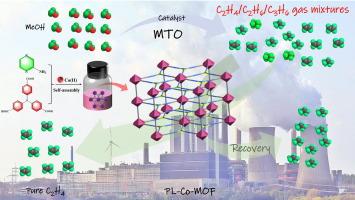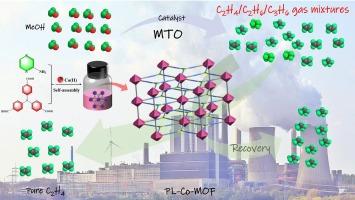合理设计氨基功能化柱状层状Co6O6簇MOF用于MTO工艺中气体净化
IF 9
1区 工程技术
Q1 ENGINEERING, CHEMICAL
引用次数: 0
摘要
近年来,甲醇制烯烃(MTO)反应的商业化取得了重大进展。作为 MTO 反应的主要产物,C3H6 和 C2H4 的分离对化学工业具有重要意义。本研究介绍了一种创新的超微孔框架--氨基功能化柱层 Co6-Cluster 金属有机框架(PL-Co-MOF),它是利用 4-(4-羧基-N-(4-羧基苯基)苯胺基)苯甲酸(NTA)、2-氨基吡嗪(NH2-Pyz)和钴盐在溶热条件下合成的。X 射线衍射分析证实了 PL-Co-MOF 的详细结构和相纯度。计算得出的分子静电势与框架和 MTO 气体客体的相互作用相匹配。实验数据表明,在 298 K 和 10 kPa 条件下,PL-Co-MOF 对 C3H6 的吸附量明显高于对 C2H4 的吸附量。这一证据证明,PL-Co-MOF 对 C3H6/C2H4 的 50/50 比率(8.61)具有卓越的选择性。突破性实验证实了 PL-Co-MOF 从 C3H6/C2H4 混合物中分离 C2H4 的有效性,C2H4 的洗脱时间达到 46.6 分钟/克。理论计算表明,PL-Co-MOF 优异分离性能的来源是 Co6O6 团簇中的氧位点和 NH2-Pyz 中的氨基;气体的原位傅立叶变换红外进一步验证了理论计算结果中 Co6O6 团簇和氨基的吸收位点,补充解释了 MTO 气体分子和框架的真实分离过程。这凸显了合理构建 MOFs 对于实现高效多组分分离的重要性。这项工作旨在推进吸附分离技术,提高 MTO 工艺的气体纯度。本文章由计算机程序翻译,如有差异,请以英文原文为准。


Rational design of amino-functionalized pillar-layered Co6O6 cluster MOF for gas purification in the MTO process
The commercialization of the methanol-to-olefins (MTO) reaction has made significant progress in recent years. As the main products of the MTO reaction, the separation of C3H6 and C2H4 is of important significance for the chemical industry. This study introduces Amino-Functionalized Pillar-Layered Co6-Cluster Metal-Organic Framework (PL-Co-MOF), an innovative ultra-microporous framework synthesized using 4-(4-carboxy-N-(4-carboxyphenyl)anilino)benzoic acid (NTA), 2-aminopyrazine (NH2-Pyz), and cobalt salts under solvothermal conditions. The X-ray diffraction analysis was employed to confirm the detailed structure and phase purity of PL-Co-MOF. The calculated molecular electrostatic potential matches the interaction of the framework and MTO gas guest. The experimental data demonstrate that PL-Co-MOF exhibits a significantly higher adsorption of C3H6 in comparison to C2H4 at 298 K and 10 kPa. This evidence supports the exceptional selectivity of PL-Co-MOF towards a 50/50 C3H6/C2H4 ratio, which is 8.61. Breakthrough experiments confirm its effectiveness in separating C2H4 from C3H6/ C2H4 mixtures, with C2H4 elution time reached 46.6 min/g. Theoretical calculations reveal that the origin of excellent separation performance of a PL-Co-MOF is due to the oxygen sites in the Co6O6 clusters and the amino groups in NH2-Pyz; In-situ FTIR of gases further verifies the absorption sites of the Co6O6 clusters and the amino groups in theoretical calculation results, which complementarily explains the real separation process of MTO gas molecules and frameworks. This highlights the importance of rational construction of MOFs for achieving efficient multicomponent separation. This work aims to advance adsorption separation technology and improve the gas purity of the MTO process.
求助全文
通过发布文献求助,成功后即可免费获取论文全文。
去求助
来源期刊

Separation and Purification Technology
工程技术-工程:化工
CiteScore
14.00
自引率
12.80%
发文量
2347
审稿时长
43 days
期刊介绍:
Separation and Purification Technology is a premier journal committed to sharing innovative methods for separation and purification in chemical and environmental engineering, encompassing both homogeneous solutions and heterogeneous mixtures. Our scope includes the separation and/or purification of liquids, vapors, and gases, as well as carbon capture and separation techniques. However, it's important to note that methods solely intended for analytical purposes are not within the scope of the journal. Additionally, disciplines such as soil science, polymer science, and metallurgy fall outside the purview of Separation and Purification Technology. Join us in advancing the field of separation and purification methods for sustainable solutions in chemical and environmental engineering.
 求助内容:
求助内容: 应助结果提醒方式:
应助结果提醒方式:


